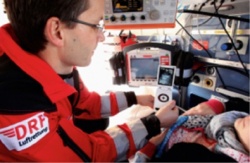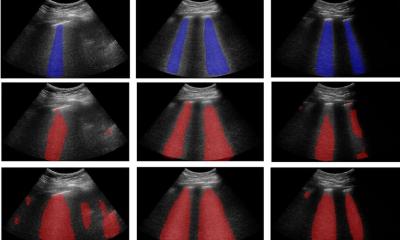The potential of ultrasound looks inexhaustible
Experts from DEGUM, the German Society for Ultrasound in Medicine, are convinced that the use of ultrasound in preclinical and clinical emergency medicine can be further optimised, according to interim study results that indicate, in cases of unclear symptoms, the diagnosis and therefore decision for appropriate A&E treatment can be accelerated by using ultrasound.

The overall hospital length of stay can also be shortened significantly. Be it to detect an abdominal aortic aneurysm quickly or to treat a pneumothorax with the help of ultrasound – the advocates of ultrasound are convinced of the procedure‘s immediate benefit in preclinical and clinical emergency medicine. ‘For us, ultrasound is part of the clinical examination,’ says Professor Joseph Osterwalder MD, Senior Consultant in the A&E department at the St. Gallen Cantonal Hospital, Switzerland, and speaker of the Working Group for Emergency Ultrasound at DEGUM. ‘And,’ he adds, ‘for me it’s the stethoscope of the future.’
He particularly points out that, when a patient is in considerable pain and screams, this kind of imaging is ideal. ‘When there’s a high level of noise it’s impossible to auscultate the heart and lungs and to go into the finer details, but with ultrasound what’s wrong with the patient is immediately visible.’
However, is a comprehensive use of ultrasound in emergency medicine really necessary? Do investments in the hardware and training – especially for preclinical medicine – actually pay off? Currently, not many studies exist on this topic – if only because randomised controlled studies in these acute emergency situations are not possible for ethical reasons.
This is also the problem which Andreas Schuler MD, Member of the Board at DEGUM and senior consultant at the Helfenstein Klinik Geislingen faced. As head of the first multi-centre study worldwide into the benefit of ultrasound in A&E, he and his team wanted to prove scientifically that the early use of ultrasound by trained staff in the hospital A&E department accelerates diagnosis and therapy and helps to shorten the duration of hospital stays.
To date there are only preliminary results of this PRIMUS Study (Primary Ultrasound as an Imaging Method for Patients in the Emergency Department) available. As stated in the previous article (page 23), the study was carried out in the A&E departments of six different hospitals with more than 1,400 patients. Only patients with unclear symptoms where a diagnosis could either be confirmed or excluded by using ultrasound were involved.
These patients were initially treated according to the instructions of the doctor in charge of the department at the time. If there was an urgent indication, and as long as the situation in the respective A&E department permitted it, the ultrasound examination was carried out immediately (within the first 24 hours: group 1) or later (after 24 hours: group 2).
In a comparison of these two groups, it becomes apparent that the average duration of stay amongst patients in the first group is almost 40%, i.e. significantly shorter than those of the second group. Biometricians are currently comparing the respective diagnosis groups (ICD groups) to rule out other causes for the different durations of stay, and the results of this analysis are due this year.
A further interim result of the study: the immediate use of ultrasound resulted in an immediate indication for further treatment in more than 50% of cases examined; in around 47% of cases it was helpful for differentiating the diagnosis and in only 2.6% of cases did ultrasound have no impact at all on treatment decisions. However, Dr Schuler said, professional experience with ultrasound is the prerequisite for full utilisation of the procedure’s potential. At all times during day and night, the doctor in charge, irrespective of his medical specialism, should be comprehensively trained in the use of ultrasound for acute emergency situations, in A&E as well as the preclinical medicine.
To ensure this, DEGUM has developed a simple training programme. ‘One of the reasons why emergency ultrasound has to date been used far too infrequently is the dogma that ultrasound diagnostics should be the responsibility of the specialists of the respective medical fields,’ says Prof. Osterwalder – who was involved in the development of this curriculum with the Working Group for Emergency Ultrasound. The patient should receive an ultrasound examination directly at the initial location of treatment by the first doctor in charge – the key demand made by the DEGUM specialists. They are therefore calling for comprehensive use of ultrasound for emergency situations, in the A&E department as well as in preclinical medicine.
Air Rescue is ahead of rescue services on the ground, which to date have only been equipped with mobile ultrasound scanners in the context of studies or projects. The DRF German Air Rescue was the pioneer – it has gradually been introducing mobile ultrasound scanners and training staff since 2004. Since 2013 training has been based on the curriculum developed by DEGUM, press officer Stefanie Kapp explains.
ADAC Air Rescue also places considerable importance on ultrasound according to Michael Gässler MD, of the ADAC medical division. With an experienced user, he says, ultrasound can quickly result in the confirmation of a suspected diagnosis. However, he also warns: ‘on the other hand, insufficient experience with the procedure and the equipment can lead to delays and incorrect diagnoses.’ Comprehensive training and instructions are therefore indispensable. The ADAC Air Rescue runs its own training programme.
* Pilot study results on PRIMUS were published in the Journal of Medical Ultrasound: Benefit of early abdominal ultrasonography in non-surgical patients admitted to the emergency department: a pilot study by David Arkadij Albrecht et al. (Journal of Medical Ultrasound;Volume 38, Number 4, October 2011, pp. 203-208)
Profile:
Professor Joseph Osterwalder MD, Senior Consultant at the Central A&E Department of the St. Gallen Cantonal Hospital, Switzerland, studied medicine at Swiss universities in Fribourg and Zurich and wrote his doctorate on a clinical-epidemiological topic in neurosurgery. He also gained a Masters in International Health at Harvard University, USA. A fellow of the European Society of Emergency Medicine, Prof. Osterwalder has worked in clinical emergency medicine for 25 years, gained numerous additional qualifications in this field, also working for years as a medic in war zones for the International Committee of the Red Cross.
11.09.2013











